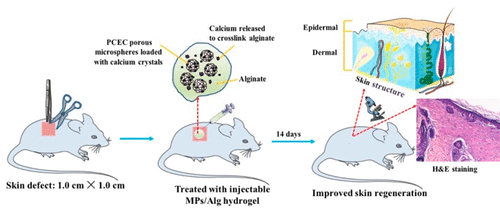当前位置:
X-MOL 学术
›
ACS Biomater. Sci. Eng.
›
论文详情
Our official English website, www.x-mol.net, welcomes your
feedback! (Note: you will need to create a separate account there.)
Injectable Hybrid Poly(ε-caprolactone)-b-poly(ethylene glycol)-b-poly(ε-caprolactone) Porous Microspheres/Alginate Hydrogel Cross-linked by Calcium Gluconate Crystals Deposited in the Pores of Microspheres Improved Skin Wound Healing
ACS Biomaterials Science & Engineering ( IF 5.4 ) Pub Date : 2018-02-06 00:00:00 , DOI: 10.1021/acsbiomaterials.7b00860 JinFeng Liao 1, 2 , YanPeng Jia 1 , BeiYu Wang 1 , Kun Shi 1 , ZhiYong Qian 1
ACS Biomaterials Science & Engineering ( IF 5.4 ) Pub Date : 2018-02-06 00:00:00 , DOI: 10.1021/acsbiomaterials.7b00860 JinFeng Liao 1, 2 , YanPeng Jia 1 , BeiYu Wang 1 , Kun Shi 1 , ZhiYong Qian 1
Affiliation

|
In our study, a hybrid alginate hydrogel cross-linked by calcium gluconate crystals deposited in poly(ε-caprolactone)-b-poly(ethylene glycol)-b-poly(ε-caprolactone) (PCL-PEG-PCL, abbreviated as PCEC) porous microspheres was developed for skin engineering. The diameter of microspheres was ∼212 μm, and the pore size was ∼8 μm. The PCEC porous microspheres supplied different functions in the hydrogel: (1) Calcium gluconate crystals were loaded in the inner pores of the microspheres, which can induce alginate hydrogel to cross-link in a few minutes once they were mixed. (2) The porous structure of the microspheres provided more anchor points for fibroblast attachment and growth, resulting in the enhancement of cell growth in the hybrid hydrogel. The PCEC microspheres/Alg hydrogel (MPs/Alg hydrogel) possessed excellent compatibility, because cell viability remained around 100% even at a concentration of 500 μg/mL. Meanwhile, the morphology of 3T3 and L929 cells attached on both PCEC porous microspheres and MPs/Alg hydrogel were confirmed by confocal laser spectrometry (CLSM). What’s more, MPs/Alg hydrogel promoted wound regeneration in a full-thickness skin defect model of rats. The mild inflammation reaction existed at the early stage of wound repair and gradually disappeared. These findings suggested that MPs/Alg hydrogel may possess great potential in the application of skin tissue engineering.
中文翻译:

可注射杂化聚(ε-己内酯)-b-聚(乙二醇)-b-聚(ε-己内酯)多孔微球/藻酸盐水凝胶,其通过沉积在微球孔中的葡萄糖酸钙晶体交联,改善了皮肤伤口的愈合
在我们的研究中,杂化藻酸盐水凝胶与沉积在聚(ε-己内酯)-b-聚(乙二醇)-b中的葡萄糖酸钙晶体交联开发了聚(ε-己内酯)(PCL-PEG-PCL,缩写为PCEC)多孔微球,用于皮肤工程。微球的直径为〜212μm,孔径为〜8μm。PCEC多孔微球在水凝胶中提供不同的功能:(1)葡萄糖酸钙晶体装载在微球的内孔中,一旦混合,藻酸盐水凝胶会在几分钟内引起交联。(2)微球的多孔结构为成纤维细胞的附着和生长提供了更多的锚点,从而增强了杂化水凝胶中细胞的生长。PCEC微球/ Alg水凝胶(MPs / Alg水凝胶)具有出色的相容性,因为即使在浓度为500μg/ mL的情况下,细胞活力仍保持在100%左右。同时,共聚焦激光光谱法(CLSM)证实了附着在PCEC多孔微球和MPs / Alg水凝胶上的3T3和L929细胞的形态。此外,MPs / Alg水凝胶可促进大鼠全层皮肤缺损模型中的伤口再生。轻度炎症反应存在于伤口修复的早期,并逐渐消失。这些发现表明,MPs / Alg水凝胶在皮肤组织工程的应用中可能具有巨大的潜力。
更新日期:2018-02-06
中文翻译:

可注射杂化聚(ε-己内酯)-b-聚(乙二醇)-b-聚(ε-己内酯)多孔微球/藻酸盐水凝胶,其通过沉积在微球孔中的葡萄糖酸钙晶体交联,改善了皮肤伤口的愈合
在我们的研究中,杂化藻酸盐水凝胶与沉积在聚(ε-己内酯)-b-聚(乙二醇)-b中的葡萄糖酸钙晶体交联开发了聚(ε-己内酯)(PCL-PEG-PCL,缩写为PCEC)多孔微球,用于皮肤工程。微球的直径为〜212μm,孔径为〜8μm。PCEC多孔微球在水凝胶中提供不同的功能:(1)葡萄糖酸钙晶体装载在微球的内孔中,一旦混合,藻酸盐水凝胶会在几分钟内引起交联。(2)微球的多孔结构为成纤维细胞的附着和生长提供了更多的锚点,从而增强了杂化水凝胶中细胞的生长。PCEC微球/ Alg水凝胶(MPs / Alg水凝胶)具有出色的相容性,因为即使在浓度为500μg/ mL的情况下,细胞活力仍保持在100%左右。同时,共聚焦激光光谱法(CLSM)证实了附着在PCEC多孔微球和MPs / Alg水凝胶上的3T3和L929细胞的形态。此外,MPs / Alg水凝胶可促进大鼠全层皮肤缺损模型中的伤口再生。轻度炎症反应存在于伤口修复的早期,并逐渐消失。这些发现表明,MPs / Alg水凝胶在皮肤组织工程的应用中可能具有巨大的潜力。











































 京公网安备 11010802027423号
京公网安备 11010802027423号